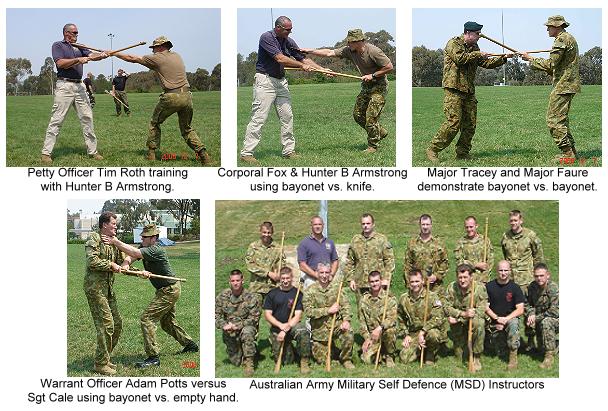Into the warren of dark tunnels the men leapt, followed by wave on wave of reinforcements until the trenches were choked with dead and wounded men. No bombs were used. The fighting was too close for this. Rifles, but mostly bayonets and at times, hands did the killing. By 6pm Lone Pine had been taken.
Lone Pine
The ANZACS
Patsy Adam –Smith, 1978
Introduction
The Australian soldier has been instructed in formalised unarmed combat training since the early 1940s. While this training was effective in many theatres of war, it was often given in an improvised and individualised manner and has relied on the skill sets of various individuals with a strong commitment and interest to the delivery of the training.
Today the Australian Army instructs their soldiers in Close Quarter Fighting (CQF) and Military Self Defence (MSD). CQF is taught to combat arms and MSD is taught to all members of the Australian Army.
MSD is a skill that will become increasingly important to the Australian Soldier of the 21st Century. A soldier trained in MSD has the ability to employ those skills without the use of unnecessary or inappropriate force, giving a greater range of responses and providing flexibility in ambiguous situations. MSD also fosters the warrior spirit and encourages ingenuity and resilience.
MSD is an integrated program which incorporates the applicable use of force, physical self defence concepts and techniques, with current weapon systems, combat equipment, individual and team tactics employed by soldiers in the operational environment.
Mr Hunter Armstrong provided the Australian Army Military Self Defence (MSD) Instructors with four days of Combative Mindset (CM) training from 05-08 Dec 06.
The training was divided into a one day exposure course for selected MSD supervisors and a three day training package for senior instructors. The concept was to expose as many MSD Supervisors/Instructors to Mr Armstrong’s concepts and training methodologies. At the same time a selected group of instructors were able to study in detail and gain a greater level of understanding of these concepts and how they relate to the modern battlefield.
Topics covered during the three days ranged from combative behaviour and performance background, biomechanics, vision, looming and many training drills with the bayonet trainer.
The training involved both theory lectures and practical sessions.
Theory
Mr Hunter Armstrong’s knowledge of the origins of the CM and the development of the warrior through history is extensive. This knowledge formed the basis for the theory lectures provided during the CM training. Mr Hunter Armstrong was found to be an engaging and powerful communicator. The lectures were well received by all participants and they provided a solid foundation for the practical sessions to follow. Mr Hunter Armstrong’s thoughts and arguments are well grounded in thorough research and provide the participant with a clear context in which to apply the subsequent practical techniques.
Practice
The practical sessions challenged participants to engage their CM. Predatory style drills were used to simulate unarmed, fixed bayonet and unfixed bayonet engagements at close range. The drills taught participants to utilise ambient vision and direct, aggressive entry to defeat the enemy. Mr Hunter Armstrong’s CM training emphasises the functionality of all movements to achieve the aim. You do not move off line to avoid a blade – you move off line to achieve entry to the enemy. This focus was found to be extremely beneficial. Overall, the practical sessions left participants with the initial skills and mindset to nurture the warrior within.
Application
The application of Mr Hunter Armstrong’s CM training for MSD Supervisors is now the challenge. Some of our training methods appear on face value to be inconsistent with the practical sessions of the CM training. Small changes in process and emphasis may be required to ensure that we can achieve our aims whilst enhancing the development of the CM of the MSD exponents we produce. Such development of the MSD course, with future involvement from Mr Hunter Armstrong, could enable us to substantially improve our ability to mentally prepare the soldiers we train for real combat.
Conclusion
Mr Hunter Armstrong provided 4 days of excellent CM training for Australian Army MSD Supervisors. Both the theory and practical sessions were well received and all participants reported the experience as highly beneficial. The challenge now lies for us in applying this combative mindset to our MSD training and assisting our soldiers to develop into warriors.
